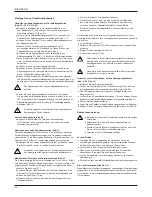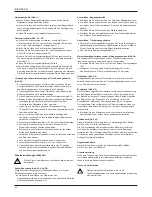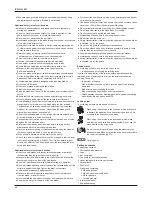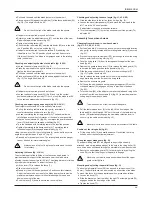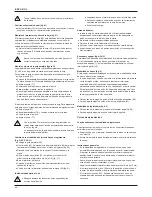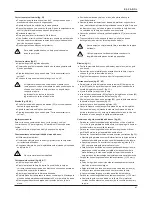
35
E N G L I S H
● Pull down the head until the blade just enters the saw kerf.
● Place a square (66) against the left side (7) of the fence and blade (62)
(fi g. G2). The angle should be 90°.
Do not touch the tips of the blade teeth with the square.
● If adjustment is required, proceed as follows:
● Rotate the eccentric adjustment bush (67) until the face of the saw
blade is fl at against the square (fi g. G1).
● Tighten the locking screw (65).
● Check that the red marks (68) near the blade slot (52) are in line with
the 0° position (69) on the two scales (fi g. H).
● If adjustment is required, loosen the screws (70) and bring the
indicators in line. The 45° position should now also be accurate.
If this is not the case, the blade is not perpendicular to the rotating
table (see below).
Checking and adjusting the blade to the table (fi g. I1 & I2)
● Loosen the bevel clamp knob (22) (fi g. I1).
● Press the saw head to the right to ensure it is fully vertical and
tighten the bevel clamp handle.
● Pull down the head until the blade just enters the saw kerf.
● Place a set square (66) on the table and up against the blade (62)
(fi g. I2). The angle should be 90°.
Do not touch the tips of the blade teeth with the square.
● If adjustment is required, proceed as follows:
● Loosen the bevel clamp knob (22) (fi g. I1) and turn the vertical
position adjustment stop screw (71) in or out until the blade is at 90°
to the table as measured with the square (fi g. I2).
Checking and adjusting the mitre angle (fi g. A1, A2 & H)
The straight cross-cut and 45° mitre positions are pre-set.
● Pull up the rotating table location plunger (8) and rotate it
counterclockwise a quarter of a turn (fi g. A1).
● Loosen the rotating table clamp handle (5). The handle allows a
ratchet-type action when full rotation of the handle is not possible.
● Grip the control handle (14) (fi g. A2), compress the guard retraction
lever (13) and lower the saw about halfway (fi g. A1).
● Turn the sawhead with its rotating table to the required position.
● Tighten the rotating table clamp handle (5). The rotating table
location plunger (8) will engage automatically (fi g. A1).
Using the red marks (68), the rotating table (4) can be set to any mitre
angle left or right between 0° and 45° (fi g. H).
● Proceed as for pre-set positions. The rotating table location plunger
cannot be used for intermediate angles.
Always make a trial cut in a piece of waste wood, to check
for accuracy.
Adjusting the fence (fi g. J1 & J2)
The moveable part of the left side of the fence can be adjusted to
provide maximum support of the workpiece near the blade, while
allowing the saw to bevel to a full 45° left. The sliding distance is limited
by stops in both directions. To adjust the fence (7):
● Lift the lever (72) to release the fence (7).
● Slide the fence to the left.
● Make a dry run with the saw switched off and check for clearance.
Adjust the fence to be as close to the blade as practical to provide
maximum workpiece support, without interfering with the up and
down movement of the arm.
● Push the lever (72) down to secure the fence in place.
Checking and adjusting the bevel angle (fi g. J1, K1 & K2)
● Slide the side fence to the left as far as it will go (fi g. J1).
● Loosen the bevel clamp handle (22) and move the saw head to the
left. This is the 45° bevel position.
● If adjustment is required, proceed as follows:
● Turn the stopscrew (73) in or out as necessary until the pointer (74)
indicates 45°.
Assembly for saw bench mode
Changing from mitre saw to saw bench mode
(fi g. A1 - A3, E2, L1 & L2)
● Put the blade into 0° cross-cut position with the rotating table location
plunger (8) correctly located and the rotating table clamp (5) secured
(fi g. A1).
● Slacken the riving knife clamp bolt (75) just enough to allow the riving
knife to enter the mounting slot (fi g. L1).
● Take the riving knife (16) from its storage position against the saw
head (fi g. A2).
● Depress the guard release lever (13) to release the blade guard (12),
then raise the blade guard as far as possible (fi g. A1).
● Slide the riving knife bracket (76) fully into the mounting slot (77)
(fi g. L1). Tighten the clamp bolt.
● Gently release the lower guard until it is held in place behind the
edge protruding from the inside of the riving knife.
● Remove the under-table guard.
● Pull down the saw head and swing the height adjuster (23) until its
U-shaped bracket (56) engages on the pin provided in the base
(fi g. E2).
● Turn the wheel (55) of the adjuster to make the blade and riving knife
protrude from the saw bench table (24) (fi g. A3) to provide maximum
cutting depth in saw bench mode.
The blade should not foul the lower blade guard.
● Pull the table release lever (2) to the left, lift the front edge of the
table and fl ip it back through 180° until the teeth of the table-locking
device (20) automatically engage the saw blade retention lever to
secure it in the saw bench mode (fi g. L2).
Be careful not to lose control over the movement of the table.
Position of the riving knife (fi g. M)
● Fit the riving knife (16) as described above. Once fi tted, the riving
knife does not require further adjustment.
Fitting the upper blade guard (fi g. N)
The upper blade guard (25) is designed to be quickly and easily
attached, via a spring-loaded plunger to the hole in the riving knife (16)
once it has been positioned through the worktable for saw bench mode.
● Secure the upper blade guard (25) to the riving knife by pulling the
knob (76) to allow the plunger in the guard to engage.
Never use your saw in saw bench mode without the upper
guard correctly fi tted.
Mounting and adjusting the parallel fence (fi g. O)
The dual height parallel fence (26) can be used in two positions (11 or
60 mm). The parallel fence can be mounted on either side of the blade.
To mount the fence into the appropriate position, proceed as follows:
● Loosen the knob (77).
● Slide the bracket on from the left or the right. The clamping plate (78)
engages behind the front edge of the table.
● Tighten the knob (77).
Summary of Contents for DW743
Page 1: ...DW743 ...
Page 3: ...3 3 A2 A1 10 11 8 7 14 13 12 5 6 4 3 2 9 1 21 19 20 18 14 15 16 22 17 ...
Page 4: ...4 4 A4 A5 A3 27 24 25 26 23 22 29 28 34 30 31 33 32 35 ...
Page 5: ...5 5 A8 B A6 A7 29 36 37 38 X ...
Page 6: ...6 6 C1 E1 D C2 E2 47 48 49 18 46 52 51 53 54 50 20 2 55 56 23 ...
Page 8: ...8 8 J2 J1 K1 K2 L1 L2 M N 7 72 74 22 73 75 16 12 76 77 2 20 3 8 mm 62 16 16 25 76 ...
Page 9: ...9 9 O P Q R S T U 77 78 26 79 80 81 V1 82 81 ...
Page 10: ...10 10 V3 W 84 83 85 85 V2 ...
Page 137: ...137 ...
Page 138: ...138 ...
Page 139: ...139 ...






